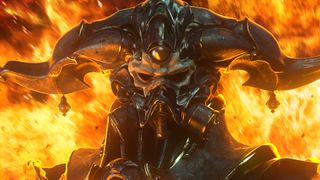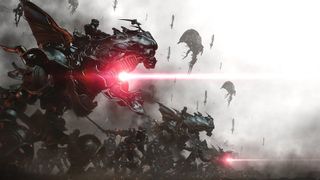Final Fantasy 14 chopped a legendary climactic dungeon in half—and it's even better now
Adding things by taking them away.

The Praetorium is the one ending everyone who plays Final Fantasy 14 is most likely to see. It's the climax to the base questline of a linear, story-focussed MMO, the one dungeon that helps players decide whether they continue on through Heavensward and the rest of the expansions—the capstone that hopefully makes them fall fully in love with an incredible game. Now the arrival of Final Fantasy 14's 6.1 patch has brought with it a thorough rework of this key location, halving the number of party members and removing some once-essential tasks.
To someone like me, a crusty old-timer who's been with the game long enough to remember the disaster that was FF14 1.0 first-hand, this dungeon means a lot: The Praetorium was a promise that things would be different from now on, that no story would be started without an ending already planned, that I could trust the new team with my time and money. Multiple cutscenes built up the drama and weight of the moment. It was a thrilling conclusion to a game that had burst into fiery success from the ashes of its own earlier public failure. I loved it.
And this patch took a chainsaw to it all.
It's now a mere four person dungeon just like Sastasha, the very first one you run through as a nervous newcomer. There's no need to visit the Identification Key Reader before activating your magitek armour, because the Identification Key Reader doesn't exist anymore. Chests? Gone. Length? Noticeably shortened. And then the dungeon abruptly stops after the boss fight that once served as its mid-point. "Well done: now go back to the duty finder if you want to see how this all ends," says patch 6.1.
This is not the Praetorium I loved running through. But it's actually been years since the Praetorium I loved could be played exactly as I remembered it.
What really happened when this dungeon came up in the duty roulette prior to the latest patch? After years of expansions it was less the exciting denouement to a tale of oppressive empires and mechanically reclaimed gods, more just… a bunch of overpowered players who are used to crushing deities before breakfast silently steamrolling a path they'd walked hundreds of times before. That wasn't the experience I adored and I'm sure it's not one any new players appreciated either. It's not so dramatic when the towering baddies are ploughed through with little effort, and probably tanked by a guy wearing a comedy Moogle outfit named, like, Buff Dude, to boot. That's not how it was supposed to go.
In this context—in today's Final Fantasy 14, nine years on—patch 6.1's unflinchingly unsentimental redesign makes perfect sense.
The biggest gaming news, reviews and hardware deals
Keep up to date with the most important stories and the best deals, as picked by the PC Gamer team.
A smaller party instantly means everyone, regardless of their personal skill level or the showy sparkle of their end endgame equipment, has to pay close attention to every attack and make sure they're contributing and cooperating to the team as fully as they should. The removed content is, if I put my sensible hat on, irrelevant to the fun parts of the run I used to look forward to. The patch also parcels off the Praetorium's final two fights against Ultima Weapon to a separate trial, and that was the right move—you want players to be excited, not exhausted, by the time they come face-to-face with these imposing instruments of war.
Thanks to this pragmatic overhaul, bosses big and small are able to unleash attacks I'd gotten used to not even seeing, let alone having to dodge, because this time around they didn't drop dead before they got around to triggering them. The stakes feel real again, hewing more closely to the tension and danger expressed in the cinematic cutscenes that frame the entire experience.

This redesign, more concerned with capturing the spirit than the letter of those early adventures, is Final Fantasy 14's design philosophy in a nutshell. This is an MMO happy to constantly reexamine itself, always conscious of what players at all levels need today, not what worked for them years ago. It's an MMO that never dares to assume people will stay just because they're already here, or that new or lapsed players will keep signing up for some fancy new gear.
It's also an MMO that considers its story to be as vital as any raid or endgame challenge; everything we hear, feel, and think between A Realm Reborn and Endwalker is a personal journey to be walked at our own pace rather than a roadblock keeping us from the endgame weekly grind. Whenever you choose to fight your way through The Praetorium—whether that's today, next month, or even a year from now—it'll always feel like your victory in an Eorzea that's forever growing alongside you; every footstep made to feel like it's being laid fresh in uncharted soil..
I'll never play The Praetorium as I first encountered it ever again. It's gone forever, consigned to old YouTube videos and dusty screenshot folders. Good. If there's one thing I hope always stays the same, it's Final Fantasy 14's willingness to embrace change.

When baby Kerry was brought home from the hospital her hand was placed on the space bar of the family Atari 400, a small act of parental nerdery that has snowballed into a lifelong passion for gaming and the sort of freelance job her school careers advisor told her she couldn't do. She's now PC Gamer's word game expert, taking on the daily Wordle puzzle to give readers a hint each and every day. Her Wordle streak is truly mighty.
Somehow Kerry managed to get away with writing regular features on old Japanese PC games, telling today's PC gamers about some of the most fascinating and influential games of the '80s and '90s.
Most Popular

